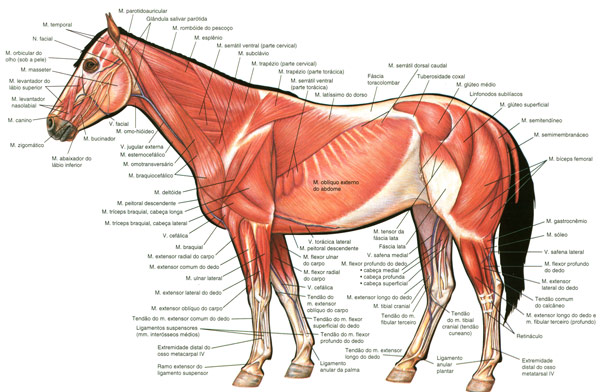Post by Admin on Dec 16, 2015 16:45:50 GMT -7

Ligaments
Ligaments attach bone to bone or bone to tendon, and are vital in stabilizing joints as well as supporting structures. They are made up of fibrous material that is generally quite strong. Due to their relatively poor blood supply, ligament injuries generally take a long time to heal.
Tendons
Tendons are cords of connective tissue attaching muscle to bone, cartilage or other tendons. They are a major contributor to shock absorption, are necessary for support of the horse’s body, and translate the force generated by muscles into movement. Tendons are classified as flexors (flex a joint) or extensors (extend a joint). However, some tendons will flex multiple joints while extending another (the flexor tendons of the hind limb, for example, will flex the fetlock, pastern, and coffin joint, but extend the hock joint). In this case, the tendons (and associated muscles) are named for their most distal action (digital flexion).
Tendons form in the embryo from fibroblasts which become more tightly packed as the tendon grows. As tendons develop they lay down collagen, which is the main structural protein of connective tissue. As tendons pass near bony prominences, they are protected by a fluid filled synovial structure, either a tendon sheath or a sac called a bursa.
Tendons are easily damaged if placed under too much strain, which can result in a painful, and possibly career-ending, injury. Tendinitis is most commonly seen in high performance horses that gallop or jump. When a tendon is damaged the healing process is slow because tendons have a poor blood supply, reducing the availability of nutrients and oxygen to the tendon. Once a tendon is damaged the tendon will always be weaker, because the collagen fibres tend to line up in random arrangements instead of the stronger linear pattern. Scar tissue within the tendon decreases the overall elasticity in the damaged section of the tendon as well, causing an increase in strain on adjacent uninjured tissue.
Muscles
When a muscle contracts, it pulls a tendon, which acts on the horse's bones to move them. Muscles are commonly arranged in pairs so that they oppose each other (they are "antagonists"), with one flexing the joint (a flexor muscle) and the other extending it (extensor muscle). Therefore, one muscle of the pair must be relaxed in order for the other muscle in the pair to contract and bend the joint properly. A muscle is made up of several muscle bundles, which in turn are made up of muscle fibers. Muscle fibers have myofibrils, which are able to contract due to actin and myosin. A muscle together with its tendon and bony attachments form an extensor or flexor unit.

Source:
en.wikipedia.org/wiki/Equine_anatomy#Ligaments_and_tendons
en.wikipedia.org/wiki/Equine_anatomy#Muscular_system
